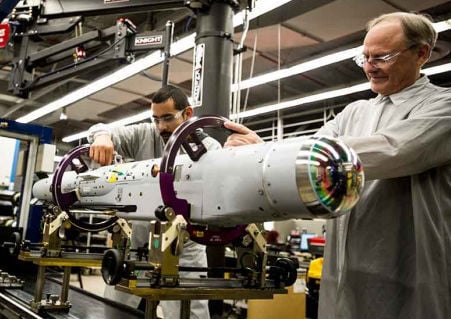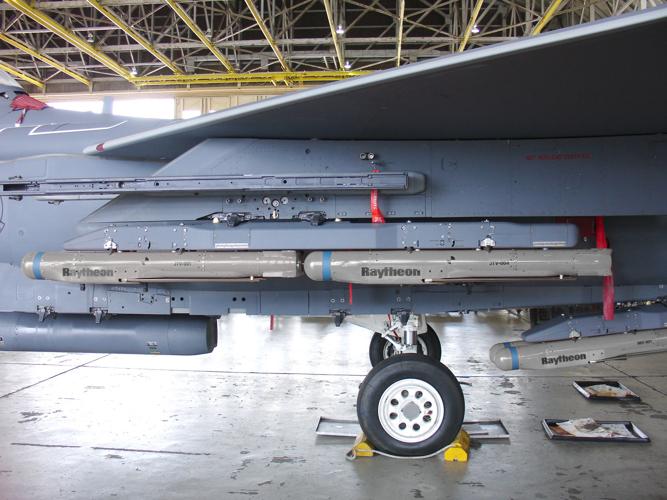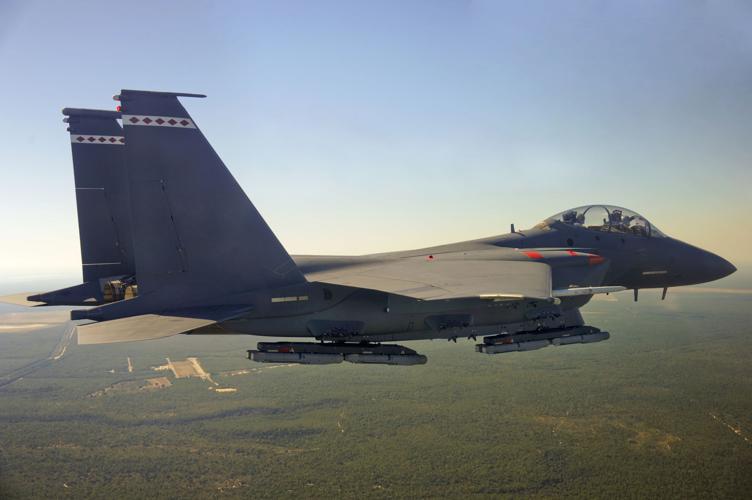A new, all-weather guided bomb developed by Tucson-based Raytheon Missile Systems is on the verge of final testing by the Air Force that would pave the way for a production program worth some $4 billion.
Raytheon’s Small Diameter Bomb II, named for its skinny, 7-inch girth, has nearly finished developmental testing by Raytheon after two successful flights at Florida’s Eglin Air Force Base in December.
Raytheon already is under contract to make more than 700 SDB IIs under more than $100 million in low-rate production contracts that started in mid-2015.
The Air Force is expected to begin operational testing in the fourth quarter, with a possible go-ahead for full production sometime in 2018.
In the most difficult tests yet for the SDB II, a government and Raytheon team showed the weapon’s ability to hit moving targets in adverse weather conditions as well as radio control of the bomb by a third-party controller, the company said.
The SDB II features a “tri-mode” seeker package that includes millimeter-wave radar to “see” targets through adverse weather, imaging infrared for enhanced target discrimination and semi-active laser, which enables the weapon to track an airborne laser designator or one on the ground.
The weapon, which has a roughly 40-mile range, also has GPS satellite guidance and includes a datalink for on-the-fly retargeted or third-party end guidance.
James Meger, a business-development manager for Raytheon’s SDB II program, said the all-weather capability is a game-changer, recalling how when he served in the Kosovo War in 1999 his unit was often idled by cloud cover.
“There are days that it’s just solid undercast of weather, and there’s really absolutely nothing we could do about it from an airpower perspective,” said Meger, a former Air Force combat pilot and colonel who retired as commander of Davis-Monthan Air Force base last year.
“That gap’s been out there since the inception of airpower. If it’s moving underneath the weather, you can’t really do anything about it; now we can,” he said.
Not only can the SDB II find targets in soupy weather, it can discriminate among potential targets on the ground by fusing data from its radar and heat-seeking infrared sensors.
“One of the things you tell the weapon is what class of vehicle you want it to look for — a wheeled vehicle, a tracked vehicle or a boat,” said Mike Heyser, another former pilot and SDB II’s other business development manager.
The roughly 200-pound, unpowered SDB II has a combined fragmentation and armor-breaching warhead weighing about 100 pounds, and its precision helps limit collateral damage, Raytheon said.
The two-way datalink, which allows other aircraft or ground controllers to control the SDB II, also offers warfighters greater capabilities.
“This weapon can be controlled from a guy sitting on the ground who’s talking directly to the weapon, without any laser designation or anything else required,” Heyser said.
Meger noted that users can also set up “exclusion zones” that you can tell the bomb to avoid to reduce the risk of hitting civilians or friendly forces.
Raytheon’s SDB II appears to be unique for its capabilities, though the latest version of the British Brimstone missile, an adaption of the U.S. Hellfire, also features radar and multiple sensors to hit moving targets in all weather.
“I know of no other country that has a small diameter bomb like we have, so we’re still ahead of the game,” said Daniel Goure, a vice president at the Lexington Institute, a Washington-based think tank.
Precision-guided weapons are trending smaller because of the need to limit collateral damage with increased accuracy and special warheads, and smaller munitions can be more effective, he said.
“I can do much better with a small, accurate weapon, it turns out, than I can with a larger, less accurate weapon,” Goure said, adding that the ability to carry more, smaller munitions adds the flexibility to hit multiple targets.
WORKING OUT THE KINKS
Development of the new smart bomb wasn’t always easy.
A couple of years ago, SDB II development was put on hold after two test-flight failures.
Those problems were fixed, but Raytheon will lose millions in additional development costs under the fixed-price SDB II contract.
“This is a new technology, and this is the first time this tri-mode seeker has been done,” Heyser said. “There were some issues early in developmental testing, which is pretty normal for a new technology start program.”
Meger said the SDB has successfully completed 25 of 28 developmental and government tests, with an 84 percent success rate on its first tests of new technologies incorporated in the bomb.
The Pentagon wants the SDB II to fit on a variety of fixed-wing aircraft. It was extensively tested on the F-15 Strike Eagle and is initially being fitted on the F-18 Super Hornet and the F-35 Joint Strike Fighter.
The F-35 eventually will carry eight of the weapons internally. The SDB II could also be mounted on some military drones, but helicopters don’t fly fast enough to use the unpowered glide bomb, Meger said.
But the F-35 outfitting is not expected until 2022, because of delayed aircraft software development, and some changes must be made for the SDB II to fit the Marine Corps’ vertical takeoff and landing version, the F-35B.
The SDB II could be a sustaining program for Raytheon, which is already Southern Arizona’s biggest private employer with about 10,000 local workers and plans to add some 1,900 workers.
Over more than a decade, the Pentagon plans to buy nearly 17,000 SDB IIs, which carry an estimated production price tag of about $125,000 a copy.
And the market for the SDB II will extend to allied partners in the F-35, including the United Kingdom, Italy and the Netherlands, potentially adding thousands of sales.
“It is a fifth-generation weapon that’s going primarily on that fifth-generation platform,” Meger said.







